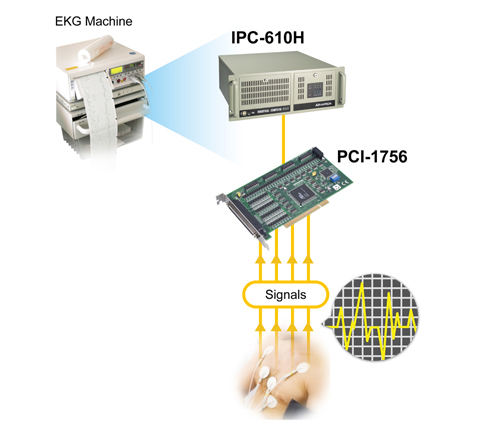Cost-effective EKG Machine for Medical Technician Training
Medical Facility
Beijing, China
|
|
Project Introduction:
Electrocardiography (EKG) is a transthoracic interpretation of the electrical activity of the heart over time captured and externally recorded by skin electrodes. EKG machines are some of the most important equipment in a hospital or medical setting, allowing medical technicians to constantly monitor the heartbeat of unconscious or sleeping patients. One of Advantech’s customers was looking for help in creating a new cost-effective EKG machine that could be used for training use.
|
System Requirements:
The EKG works mostly by detecting and amplifying the tiny electrical changes on the skin that are caused when the heart muscle "depolarises" during each heart beat. To help create machinery that is capable of monitoring these minor contractions, our client need reliable and highly accurate products with the following strict requirements:
- A vibration resistant industrial computer platform
- Convenient I/O expansion capabilities
- A PCI Card that could realize control of various signals
- High security capabilities with reliable connection to a PACS system
Project Implementation:
|
IPC-610H |
4U 14-slot Rackmount Chassis with Front-accessible USB/PS2 Connectors |
|
PCI-1756 |
64-ch Isolated Digital I/O PCI Card |
|
ADAM-3951 |
50-pin Wiring Board with LED Indicators |
|
WebAccess |
Browser based HMI/SCADA Software
|
System Diagram:

System Description:
At rest, each heart muscle cell has a charge across its outer wall. Reducing this charge towards zero is called de-polarisation, which activates the mechanisms in the cell that cause it to contract. This is detected as tiny rises and falls in the voltage between two electrodes placed either side of the heart which is displayed as a wavy line either on a screen or on paper. This display indicates the overall rhythm of the heart and weaknesses in different parts of the heart muscle. To measure these rhythms accurately, Advantech linked an industrial computer (IPC-610H) to a monitor, mouse and I/O expansion card (PCI-1756) for receiving various recorded signals. The IPC-610H acts as the dynamometer test computer while the PCI-1756 is used for connecting pneumatic switch, speed and other different signals. WebAccess is able to control and read data through the remote engineering station.
Conclusion:
This new EKG machine was not only very cost-effective compared to purchasing expensive machinery from a medical supplier, but also highly accurate and reliable, being built from industrial-grade products, with anti-interference capabilities, making it very resistant to shock and vibrations.
|